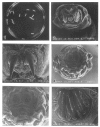Nosocomial submandibular infections with dipterous fly larvae
- PMID: 11590916
- PMCID: PMC2721075
- DOI: 10.3347/kjp.2001.39.3.255
Nosocomial submandibular infections with dipterous fly larvae
Abstract
In September 1998, a case of nosocomial cutaneous myiasis caused by Lucilia sericata (Meigen, 1826) in a 77-year-old male was found. The patient had been receiving partial maxillectomy due to the presence of malignant tumor on premaxilla. This is the first verified case involving Lucilia sericata in Taegu, Korea. In the present paper, the salient morphological features of the third instar larvae involved have been studied.
Figures

References
-
- Amitay M, Efrat M, McGarry JW, Shinwell ES. Nosocomial myiasis in an extremely premature infant caused by the sheep blowfly Lucilia sericata. Pediatr Infect Dis J. 1998;17:1056–1057. - PubMed
-
- Barrett-Conner E, Brandt SL, Simon HJ, Dechairo DC. Epidemiology for the infection control nurse. St. Louis: The CV Mosby Co.; 1978.
-
- Beaver PC, Jung RC, Cupp EW. Clinical parasitology. 9th ed. Philadelphia: Lea & Febiger; 1984.
-
- Bosniak SL, Schiller JD. Ophthalmomyiasis in an eyelid reconstruction. Am J Ophthalmol. 1990;109:101–102. - PubMed
-
- Burgess I, Davies EA. Cutaneous myiasis caused by the housefly, Musca domestica. Br J Dermatol. 1991;125:377–379. - PubMed
Publication types
MeSH terms
LinkOut - more resources
Full Text Sources

